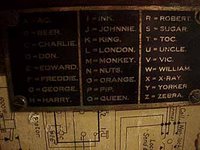
I tried the shotgun approach to a google search and typed in "alpha bravo charlie," the three words I knew. I soon learned that the alpha bravo code is a type of phonetic alphabet used by NATO. The NATO alphabet sequence is:
Alpha, Bravo, Charlie, Delta, Echo, Foxtrot, Golf, Hotel, India, Juliet, Kilo, Lima, Mike, November, Oscar, Papa, Quebec, Romeo, Sierra, Tango, Uniform, Victor, Whiskey, Xray, Yankee, Zulu
Once I knew what it was called, I tried a more concentrated search on NATO phonetic alphabet to learn the whole story. The first page returned offered some general information about phonetic alphabets. As the page explains, the title "phonetic
alphabet" is really a misnomer. Alphabets such as the NATO one do not describe the sound of the letters represented. They are just lists of words used to identify letters and avoid confusion in telephone and radio communication.
The page goes on to say that the NATO alphabet, also known as the ITU, International, and Aircraft alphabet, was developed after World War II in an attempt to internationalize the Allied Armed Forces alphabet currently in use. The spellings of certain words, such as alpha (often spelled as "alfa") and juliet (sometimes spelled "juliett") tend to vary, but the alphabet is a means for verbal communication so these slight discrepancies tend not to matter.
To learn about other phonetic alphabets, visit Phonetic Alphabets of the World or Morse Code and the Phonetic languages.
Oscar Victor Echo Romeo Alpha November Delta Oscar Uniform Tango.



































 Add my feed to your Rss
Add my feed to your Rss
